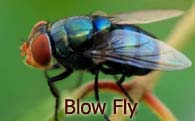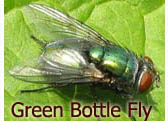Flies have always been one of the most important pests, because they are not only nuisance or annoying pests but more importantly many are vectors of pathogens that cause diseases in humans and domestic animals. These diseases include typhoid fever, salmonella, dysentery, cholera, and anthrax that are transmitted by filth flies. Some of the more common nuisance flies are House fly (Musca domestica), Face fly (Musca autumnalis), Stable fly (Stomoxys calcitrans), Little house fly (Fannia canicularis), and several species of garbage fly.
Houseflies breed readily; a female can lay up to 500 eggs in batches, in warm moist material such as animal feces, garbage, decaying vegetables, which may feed growing larva. The larva grows and pupates in 4-7 days. During warm weather, two or more generations may be completed in a month. Adult flies have sponge- sucking mouthparts that enable them to ingest only liquid foods. They liquefy the solid food by means of regurgitated saliva.





The common housefly is usually about 6-7mm long; the thorax is gray with 4 longitudinal stripes. The head has large compound eyes. The total life cycle is completed in about 8-20 days.
Habits
During day, flies are mainly gathered on or around feeding and breeding places, where mating and resting also takes place. Flies densities are highest in at mean temperature of 20-25℃. They decrease at temperature about 45℃ . and below 10℃. At very low temperature the species can stay alive in a dormant state in the adult or pupal stage. The preferred temperature for resting is 35-40℃. Oviposition, mating, feeding and flying all stop at temperature below 15 degree celsius. They are most active at low air humidity.
House flies stay within 1-3 km of their breeding place, and places where sufficient food is available. House flies are attracted to buildings by air currents and odors. During the day houseflies tend to fly or rest less than 5 feet from the ground. At night they rest on ceilings, walls, electric wires, ceiling fan corner of buildings etc. Their night time resting places are usually near their day time food sources.
We typically find adult stages of house fly and little house fly in buildings such as schools, restaurants, homes, offices, hospitals, and grocery stores. Flies seek out these locations for shelter, food and suitable breeding sites.
SOME INTERESTING FACTS
• House fly can carry a thousands of micro-organisms on their bodies, that can cause food-born illness
• Common housefly can reproduce rapidly and cause a population explosion.
• In one life time female house fly can produce more than 750 eggs, which develop into adult in just 7-10 days.
WHAT YOU CAN DO?
• Keep food articles closed, so not to come in the contact of flies.
• Keep your house and surrounding clean.
• Reduce and eliminate breeding sites.
• Do not allow accumulating garbage near your residential area.
• Use dust bin with lid.
INTEGRATED FLY MANAGEMENT SERVICE
Effective long term fly management requires an integrated approach that includes identifying threats, locating breeding sites and access points, and employing the right environmental, procedural, mechanical and chemical tactics.
• GEPCS has designed a comprehensive fly control program that addresses flies at their source; provides immediate relief from adult flies. By treating breeding media (indoors and outdoors), resting sites (outdoor) and for fast relief from adult flies treating indoor and outdoor areas.
• Fly control program is taken up from June to Nov. weekly.


